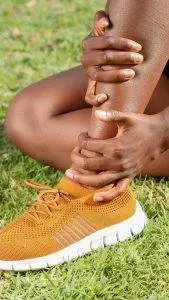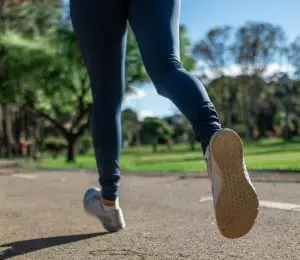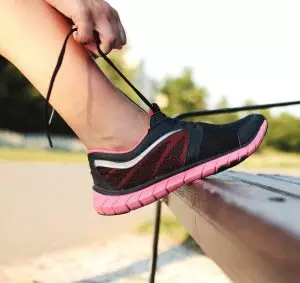By Qineng Tan, L.Ac., Ph.D. and Xiaomei Cai, L.Ac., Ph.D.

Shin pain, especially during or after exercise? Tenderness and swelling around the shin bone? These may be signs of shin splints, or a shin strain. Acupuncture and TCM can provide shin splints treatment.
Shin splints, also known as medial tibial stress syndrome (MTSS), are a common condition characterized by pain along the inner edge of the shinbone (tibia). This discomfort typically occurs during or after exercise, particularly activities that involve running, jumping, or repetitive stress on the legs.
Shin splints are often attributed to overuse or excessive strain on the muscles, tendons, and bone tissue of the lower leg. This condition involves stress to the soft tissues that causes them to become swollen and hard.
Shin splints pain can be similar to compartment syndrome symptoms, but these are two distinctly different conditions. Compartment syndrome occurs when swelling in the calf area causes a blockage of blood flow to the lower leg. This usually happens due to an injury (acute compartment syndrome) or extreme exertion (chronic exertional compartment syndrome) and causes a severe lack of oxygen in the area. Compartment syndrome usually causes severe pain, sometimes with a tingling or burning sensation, and requires medical attention.
What Causes Shin Splints?

Several factors can contribute to the development of shin splints. One of the primary causes is repetitive stress or overloading of the leg muscles, particularly those responsible for dorsiflexion (lifting the foot upwards) and supporting the arch of the foot. This can occur due to sudden increases in activity level, such as starting a new exercise regimen or intensifying training too quickly, without allowing adequate time for the body to adapt and recover.
Some people may be more prone to developing shin splints because of issues like flat feet, overpronation (excessive inward rolling of the foot), and muscle imbalances in the lower limbs can place additional strain on the shinbone and surrounding soft tissues, increasing the risk of injury.
Wearing footwear with insufficient cushioning or support, running on hard or uneven surfaces, and running downhill or on inclined terrain can all exacerbate the stress on the lower legs and contribute to the development of shin splints. Additionally, factors such as tight calf muscles, weak shin muscles, and not warming up or stretching before exercise can further increase susceptibility to this condition.
Taking care to stretch and warm up before working out, wearing shoes with enough support, and gradually increasing intensity of training can help prevent shin splints.
However, runners and athletes who play basketball or soccer are likely to experience shin splints when they are training and competing.
Shin splints treatment generally requires time and patience. Acupuncture can provide pain relief and help speed recovery from shin splints.
Top 10 Signs and Symptoms of Shin Splints
These signs and symptoms may vary in severity and duration depending on the individual and the underlying causes of shin splints.
- Pain along the inner edge of the shinbone (tibia), typically felt during or after physical activity.
- Tenderness and soreness along the shinbone, especially upon palpation or pressure.
- Swelling or inflammation of the lower leg, often localized to the area of pain.
- Dull, aching pain that may worsen with activity and subside with rest.
- Discomfort that initially occurs at the beginning of exercise but may progress to persist throughout the activity.
- Pain that gradually increases in intensity or becomes more widespread over time.
- Pain that may be accompanied by a feeling of tightness or stiffness in the muscles of the lower leg.
- Pain that persists even after cessation of activity and may interfere with daily activities.
- Possible development of small lumps or bumps along the inner border of the shinbone due to inflammation or irritation of the surrounding tissues.
- Pain that improves with rest but recurs upon resuming physical activity, especially activities that involve impact or weight-bearing on the legs.
Shin Splints Treatment

Conventional treatment of shin splints usually involves rest and over the counter pain relief. Typically, a doctor will recommend that a person with shin splints limits their exercise to low-impact activities. Icing the area several times per day is advised.
Acupuncture treatment for medial tibial stress syndrome can help relieve shin pain quickly.
One case study showed that a patient who had been suffering from shin splints for six weeks got pain relief after one session of acupuncture treatment, and at a four week follow, was still pain-free.
Can Acupuncture Help Shin Splints?
Acupuncture treatment helps with the healing of soft tissue injuries by increasing circulation to the area, relieving inflammation, and aiding in the release of endorphins for pain relief. It does this by activating Qi to move blood and energy more efficiently through the body.
One study of three groups of athletes with shin splints looked at patients who received conventional sports medicine, patients who received acupuncture, and patients who received both. The groups who received acupuncture treatment reported significantly lower pain levels and used less NSAIDs than those who did not receive acupuncture.
Acupuncture Near Me for Shin Splints in West Los Angeles
Acupuncture is an effective modality for treating many kinds of repetitive stress injuries and nerve pain conditions, including sprained ankles, Baker’s cyst, tendinitis, and carpal tunnel syndrome. Dr. Tan has over 35 years of experience helping patients find pain relief and improved mobility through treating all kinds of orthopedic and musculoskeletal conditions. While each case is unique, it is possible to get pain relief quickly with TCM treatment, including acupuncture, electro-acupuncture, therapeutic massage like Tui Na, topical herbal patches, and herbal ointments. If you are in pain and need to heal quickly to get back to your regular activities, acupuncture can help.
*This article is for education from the perspective of Traditional Chinese Medicine only. The education provided by this article is not approved by FDA to diagnose, prevent, treat and cure human diseases. It should not stop you from consulting with your physician for your medical conditions. Traditional Chinese Medicine is based on Qi, which is an invisible force that usually cannot be observed by modern science. Because science focuses on testing ideas about the natural world with evidence obtained through observation, these aspects of acupuncture can’t be studied by science. Therefore acupuncture and Chinese herbs are often not supported by double-blind, randomized trials, and they are considered alternative medicine therapies in the United States.
